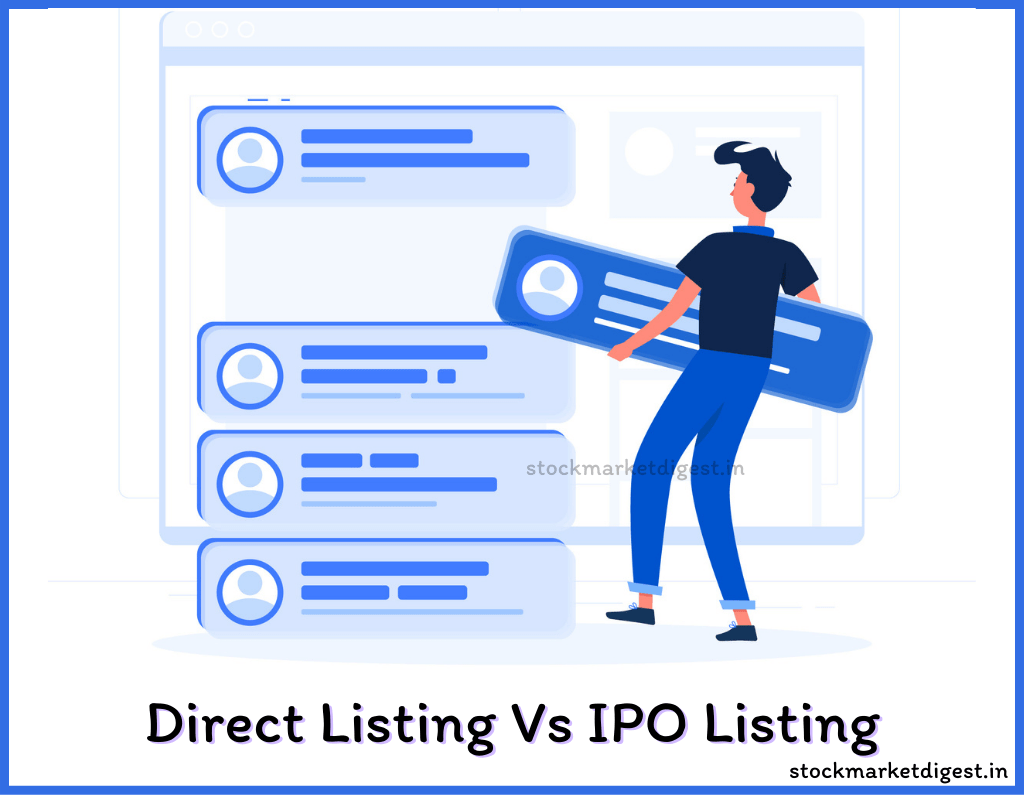In the present day, many private companies are choosing to become public entities.There are two primary paths for a private company to transition into a public one.
The first involves offering shares to the public for the first time through an Initial Public Offering (IPO), and the second is through Direct Listing or Direct Public Offering (DPO).
While both strategies serve the common goal of making companies public, they differ in various aspects such as objectives, lock-in periods, research requirements, and associated costs.
In this post, we will look in details about Direct Listing Vs IPOs and understand each one better.

What is Direct Listing or Direct Public Offering (DPO)?
Direct listing is a financial process through which a private company transitions to becoming a public company without the issuance of new shares.
In a direct listing, existing shares held by private shareholders, including promoters, investors, and employees, are made available for trading on a public stock exchange. Unlike an IPO, direct listing does not involve the creation of new shares or the participation of underwriters.
One of the distinctive features of a direct listing is the absence of intermediaries in the sale of existing stocks. This means that the company bypasses the traditional route of hiring underwriters or promoters, relying instead on market forces to determine the price of the shares.
The direct listing process is known for its cost-effectiveness, as it eliminates the need for underwriter fees and typically involves fewer regulatory formalities, making it a faster alternative to an IPO.
Direct listings provide companies with the opportunity to raise funds from the public while offering greater liquidity for existing shareholders.
However, the method is often considered more volatile, as the absence of a price discovery process through underwriters may lead to fluctuations in share prices based on market dynamics.
Overall, direct listings offer a unique and efficient pathway for companies to enter the public market and broaden their investor base.
Also Read : How to Apply for an IPO in Minor’s Name?
Benefits of Direct Listing:
- Cost-Effectiveness: Direct listings are generally more cost-effective, saving companies from underwriting fees and other expenses associated with traditional IPOs.
- Time Efficiency: Direct listings have a faster timeline, allowing companies to go public more quickly without the extended underwriting process.
- No Share Dilution: Existing shareholders maintain their ownership stakes as direct listings involve the sale of existing shares, avoiding dilution.
Cons of Direct Listing:
- Market Volatility: Direct listings can be more volatile due to the absence of underwriter support, leading to greater price fluctuations.
- Limited Capital Raised: Direct listings do not involve the issuance of new shares, limiting the capital a company can raise compared to IPOs.
- Lack of Underwriter Support: Direct listings lack the promotional and stabilizing support provided by underwriters, potentially impacting investor confidence.
Initial Public Offerring (IPO)
An Initial Public Offering is the process through which a previously private company raises capital by issuing new shares in the primary market. This method involves significant costs, regulatory obligations, and a lock-up period. Some key aspects of IPOs include:
- Raising funds: IPOs are ideal for companies seeking additional funds, a crucial aspect for their growth.
- Incredible credibility: Going public through an IPO enhances a company’s credibility and visibility, requiring transparency in reporting.
However, IPOs come with high initial costs, pressure to deliver value to investors, and higher regulatory obligations, including periodic financial reporting.
Benefits of IPO Process:
- Significant Capital Raise: IPOs allow companies to raise substantial capital by issuing new shares to the public. This infusion of funds can support expansion, research, development, and other growth initiatives.
- Enhanced Company Visibility: Going public through an IPO increases a company’s visibility and credibility in the market. It can attract attention from institutional investors, analysts, and a broader investor base.
- Share Liquidity: IPOs provide existing shareholders, including employees and early investors, with an opportunity to sell their shares on the public market, offering liquidity and potential returns.
Drawback of IPO Process:
- High Costs: IPOs involve substantial costs, including underwriting fees, legal expenses, and compliance costs. These expenses can be a significant financial burden for companies, especially smaller ones.
- Time-Consuming Process: The IPO process is time-consuming, often taking several months. This can divert management’s attention from day-to-day operations and may lead to uncertainties in the business.
- Stringent Regulatory Compliance: Public companies face increased regulatory scrutiny. Compliance with reporting requirements, disclosure regulations, and other obligations can be complex and resource-intensive.
Direct Listing Vs IPO : The Differences
| Feature | Direct Listing | Initial Public Offering (IPO) |
|---|---|---|
| Definition | Company goes public without issuing new shares. | Company issues new shares to the public. |
| Process | No underwriting process. | Involves underwriting by investment banks. |
| Price Discovery | Existing shareholders set the selling price. | Price often determined through a book-building process. |
| Capital Raise | No new shares issued; no capital raised. | Capital is raised by issuing new shares to the public. |
| Opening Price | Determined by market supply and demand. | Set by underwriters based on valuation and demand. |
| Lock-up Period | Typically, no lock-up period. | Insiders may be subject to a lock-up period. |
| Suitability | Suitable for well-known companies with an established brand. | Common for companies seeking to raise capital for expansion. |
| Market Entry | Shares immediately available for trading. | Shares subject to lock-up period before insiders can sell. |
| Example Companies | Spotify, Slack | Facebook, Alibaba |
Also Read : What are Non Convertible Debentures (NCDs) and what are its benefits?
Final Words
When you compare Direct Public Offerings (DPOs) to Initial Public Offerings (IPOs), DPOs provide a more affordable way to list shares. It’s important to note that what a direct listing doesn’t offer are the assurances in listing that underwriters provide during IPOs.
Additionally, in the comparison between direct listings and IPOs, it’s noteworthy that retail investors in direct listings may benefit from lower prices and protection against market volatility.
So, understanding the difference between IPOs and a company’s direct listing is crucial for businesses deciding to go public and for those investing in shares.
Frequently Asked Questions: Direct Listing vs. IPO
Q1. What is the main difference between Direct Listing and IPO?
Answer: The primary distinction lies in how a company goes public. In a Direct Listing, existing shares are sold to the public without creating new ones, while an IPO involves issuing new shares to the public.
Q2. How does the cost compare between Direct Listing and IPO?
Answer: Direct Listings are generally more cost-effective as they skip underwriting expenses. IPOs, on the other hand, involve significant costs, including underwriting fees, legal expenses, and compliance costs.
Q3. What is the advantage of Direct Listing in terms of time efficiency?
Answer: Direct Listings typically have a faster timeline compared to IPOs due to fewer regulatory formalities, allowing companies to go public more quickly.
Q4. How does each method affect existing shareholders?
Answer: In a Direct Listing, existing shareholders can sell their shares directly to the public without dilution. In an IPO, there may be a lock-up period, restricting the immediate sale of shares by existing shareholders.
Q5. Which method provides a significant capital raise for companies?
Answer: IPOs allow companies to raise substantial capital by issuing new shares to the public, providing a significant infusion of funds for expansion and growth.
Q6. What role does underwriter support play in IPOs?
Answer: Underwriters in IPOs provide support in stabilizing the stock price and reducing initial market volatility, which is not present in Direct Listings.
Q7. Is market volatility a concern in Direct Listings?
Answer: Yes, Direct Listings can be more volatile due to the absence of underwriter support, potentially resulting in higher price fluctuations.
Q8. How does each method impact a company’s visibility and credibility?
Answer: Direct Listings may have lower visibility initially, while IPOs enhance a company’s visibility and credibility through the underwriting process.
Q9. Can companies raise new capital in a Direct Listing?
Answer: No, Direct Listings do not involve the issuance of new shares, limiting the ability to raise new capital during the listing process.
Q10. Which approach is more suitable for a cost-conscious company?
Answer: A cost-conscious company may find Direct Listing more suitable due to its generally lower cost structure compared to the higher expenses associated with an IPO.
Don’t Miss to Read Below IPO Related Informative Articles:
- 15 Step Guide on How to Analyse an IPO
- All About Non-Convertible Debentures (NCDs)
- What Happens if IPO is Underscribed? – Benefits and Drawbacks
- What is Face Value in IPO?: How it is Different From Issue Price
- What is Book Building Process in IPO? Fixed Pricing Vs Book Building
- Most Common and Popular Key Terms Related to IPO
- What is IPO Lot Size and How It is Calculated?
- What Is Cut-Off Price in IPOs – Why is it Important?
- What is a Shelf Prospectus, Criteria and How Can it Benefit an Investor?
- What is an Oversubscribed IPO and Its Effects?
- How to Apply for an IPO Through UPI – In 7 Easy Steps
- What is Roadshow in IPO and What is its Purpose?
- 7 Key Differences Between IPO and OFS
- Difference Between Equity IPO and Debt IPO
- What is Lock-In Period in IPO? Benefits and Drawbacks

